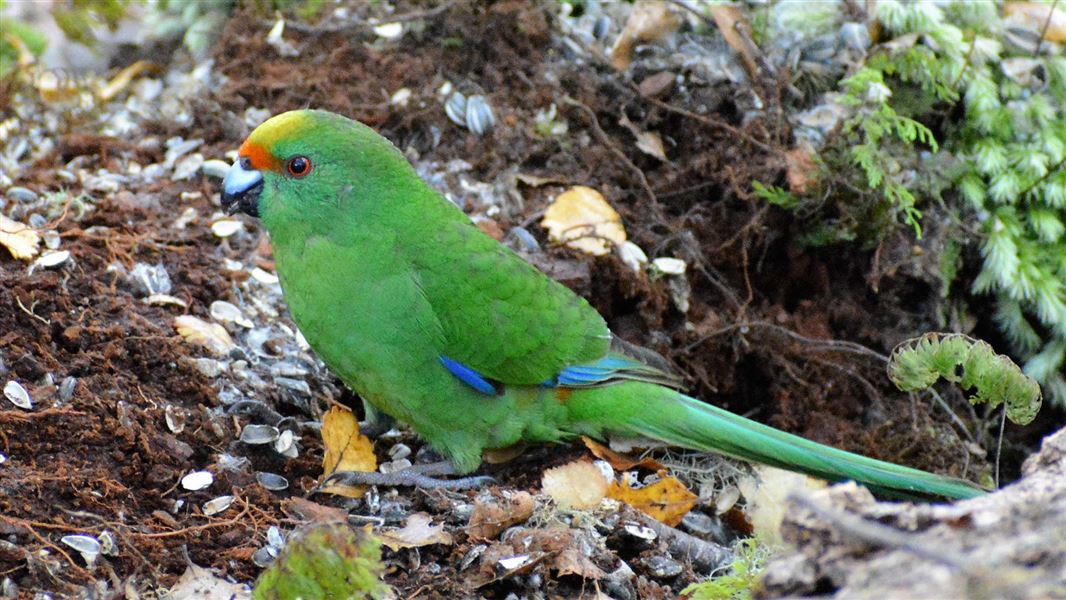Archived content: This media release was accurate on the date of publication.
Date: 06 November 2023
The bellbird-sized taonga species, also known as the orange-fronted parakeet, was first released into the sanctuary in November 2021. 125 captive-raised birds have been released there to date.
DOC Kākāriki Karaka Operations Manager Wayne Beggs says a recent survey — which played kākāriki calls to attract the birds — recorded about 170 kākāriki, although some of these may have been repeat encounters with the same individual.
“Almost all the birds we saw are the offspring of those originally released into the sanctuary, identifiable because they don’t have any coloured bands around their legs.
“We knew the kākāriki had been breeding well in the sanctuary, but this survey went beyond what we anticipated or hoped for. It’s a really positive sign this is good habitat for kākāriki karaka to thrive.
“Conditions have been great for breeding with lots of food available. We know kākāriki karaka can breed for up to 18 months straight when conditions are right, and it looks like the birds here have been making the most of it.
Current population models indicate there are between 136 and 214 kākāriki karaka in the sanctuary in total. Additional monitoring would be useful to refine these estimates and substantiate the recent survey results.
“As a boom-and-bust species, we expect to see their population fluctuate naturally,” Wayne says.
“Establishing new successful sites is crucial for this species, which has been just hanging on in some places.”
Te Rūnanga o Ngāi Tahu Kākāriki Karaka Representative Yvette Couch-Lewis is thrilled with the survey result.
“We are so grateful to Brook Waimārama Sanctuary for caring for our taonga and providing a safe habitat for the manu to flourish. We can’t wait to see this population continue to strengthen as a stronghold of kākāriki karaka.”
Te Tauihu (top-of-the-south region) iwi are delighted with the current success with this taonga species, and the cooperation displayed throughout the translocations.
Brook Waimārama Sanctuary Chief Executive Ru Collin says: "In light of the success of the re-introduction of the species, The Brook Waimārama Sanctuary has also announced it will be campaigning for the kākāriki karaka in the 'Bird of the Century' Competition, marking 100 years of Forest and Bird.
“The Sanctuary hopes the good survey results will help to raise awareness about the species in its fight back from the brink of extinction.”
Meanwhile, planning work for the next proposed new kākāriki karaka release site, at Pukenui/Anchor Island in the Dusky Sound, Fiordland, recently received a big boost when RealNZ’s annual Conservation Ball raised $175,000 for the project.
Work assessing the island for suitability continues with hopes the first kākāriki karaka will be released there in spring 2024.
DOC works in partnership with Te Rūnanga o Ngāi Tahu to lead the Kākāriki Karaka Recovery Programme, with crucial support from The Isaac Conservation and Wildlife Trust, Orana Wildlife Park, MainPower, Christchurch Helicopters, and the University of Canterbury.
The programme’s work includes extensive predator control through the mainland habitat of kākāriki karaka, captive breeding, and maintaining a population on a predator-free offshore island.
Background information
Kākāriki karaka/orange-fronted parakeet were once commonplace across throughout New Zealand, but their distribution decreased rapidly over the last century. They have twice been declared extinct (in 1919 and 1965) and then rediscovered.
They are currently found in the Hurunui South Branch in Lake Sumner (Hoka Kura) Forest Park, the Hawdon Valley in Arthur’s Pass National Park, the Brook Waimārama Sanctuary in Nelson, and on predator-free Ōruawairua/Blumine Island in the Marlborough Sounds.
The recovery programme works closely with partners such as The Isaac Conservation and Wildlife Trust and Orana Wildlife Park. Their captive breeding programme work is vital to the survival of the species.
MainPower, Canterbury University, RealNZ, Formthotics, the NZ Nature Fund and Christchurch Helicopters also support the programme.
The main threats to kākāriki karaka are introduced predators and habitat destruction. They are especially at risk from rat and stoat plagues following beech forest masts (mass seeding) – for example, one valley population declined by 85% due to a rat plague in 2001.
Read more about Brook Sanctuary.
Contact
For media enquiries contact:
Email: media@doc.govt.nz
